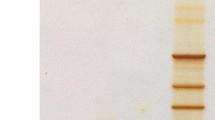Abstract
Several phosphomonoesterases and diesterases with various pH optima have been observed inAcinetobacter lwofi JW11. The osmotic shock fluids contained only those with an alkaline pH optimum. The synthesis of these phosphatases was regulated by external Pi concentrations. The shock fluids were fractionated by chromatography, yielding three fractions, two of which had hydrophobic properties. One of these contained an alkaline phosphatase that specifically required Ca2+ for activity. The diesterases required various divalent cations for their function. Mutants that lack phosphomonoesterase or both phosphomonoesterase and phosphodiesterase activities were isolated.
Similar content being viewed by others
Literature Cited
Berka RM, Vasil ML (1982) Phospholipase C (heat-labile hemolysin) ofPseudomonas aeruginosa: purification and preliminary characterization. J Bacteriol 152:239–245
Bradford MM (1976) A rapid and sensitive method for quantitation of microgram quantities of protein using the principle of protein dye binding. Anal Biochem 72:248–254.
Dassa E, Cahu M, Desjoyaux-Cherel B, Boquet PL (1982) The acid phosphatase with optimum pH of 2.5 ofEscherichia coli. J Biol Chem 257:6669–6676
Dvorak HF, Brockman RW, Heppel LA (1967) Purification and properties of two acid phosphatase fractions isolated from osmotic shock fluid ofEscherichia coli. Biochemistry 6:1743–1751
Garen A, Levinthal C (1960) A fine-structure genetic and chemical study of the enzyme alkaline phosphatase ofEscherichia coli. I. Purification and characterization of alkaline phosphatase. Biochim Biophys Acta 28:470–483
Halvorson HO, Suresh N, Roberts MF, Coccia M, Chikarmane HM (1987) Metabolically active surface polyphosphate pool inAcinetobacter lwoffi. In: Torriani-Gorini A, Rothman FG, Silver S, Wright A, Yagil E (eds). Phosphate metabolism and cellular regulation in microorganisms. Washington DC: American Society for Microbiology, pp 220–224
Kier LD, Weppelman R, Ames BN (1977) Resolution and purification of three periplasmic phosphatases ofSalmonella typhimurium. J Bacteriol 130:399–410
Kier LD, Weppelman R, Ames BN (1977) Regulation of two phosphatases and a cyclic phosphodiesterase ofSalmonella typhimurium. J Bacteriol 130:420–428
Malamy M, Horecker BL (1961) The localization of alkaline phosphatase inEscherichia coli K12. Biochem Biophys Res Commun 5:104–108
Miller JH (1974) In: Experiments in molecular genetics. Cold Spring Harbor, N.Y.: Cold Spring Harbor Laboratory, p 138
Neu HC (1968) The 5′-nucleotidase and cyclic phosphodiesterases of the Enterobacteriaceae. J Bacteriol 95:1732–1737
Neu HC, Chou J (1967) Release of surface enzymes in Enterobacteria by osmotic shock. J Bacteriol 94:1934–1945
Neu NC, Heppel LA (1965) The release of enzymes fromEscherichia coli by osmotic shock and during the formation of spheroplasts. J Biol Chem 240:3685–3692
Oliver DB (1987) Periplasm and protein secretion. In: Ingraham JL, Low KB, Magasanik B, Schaechter M, Umbarger HE (eds)Escherichia coli andSalmonella typhimurium, cellular and molecular biology. Washington DC: American Society for Microbiology, pp 56–69
Suresh N, Warburg R, Timmerman M, Wells J, Coccia M, Roberts MF, Halvorson HO (1985) New strategies for the isolation of microorganisms responsible for phosphate accumulation. Water Sci. Technol. 17:99–111
Torriani A (1960) Influence of inorganic phosphate in the formation of phosphatases byEscherichia coli Biochim Biophys Acta 38:460–479
Torriani A, Ludtke DL (1985) The Pho regulon ofEscherichia coli. In: Schaechter M, Neidhart FC, Ingraham JL, Kjeldgaard NO (eds) The molecular biology of bacterial growth. Boston: Jones and Bartlett, pp 224–242
Von Hofsten B (1961) Acid phosphatase and growth ofEscherichia coli. Biochim Biophys Acta 48:171–181
Weppelman R, Kier LD, Ames BN (1977) Properties of two phosphatases and a cyclic phosphodiesterase ofSalmonella typhimurium. J Bacteriol 130:411–419
Author information
Authors and Affiliations
Rights and permissions
About this article
Cite this article
Yashphe, J., Chikarmane, H., Iranzo, M. et al. Phosphatases ofAcinetobacter lwoffi. Localization and regulation of synthesis by orthophosphate. Current Microbiology 20, 273–280 (1990). https://doi.org/10.1007/BF02089423
Issue Date:
DOI: https://doi.org/10.1007/BF02089423




